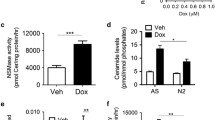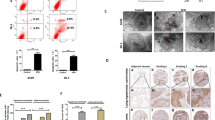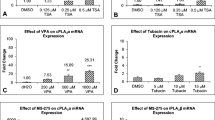Abstract
We here investigated the anticancer mechanism of 1-stearoyl-sn-glycero-3-phosphocholine (LPC), one of the lysophosphatidylcholines, in chronic myelogenous leukemia (CML) K562 cells. LPC significantly showed cytotoxicity at 80 μM and induced apoptosis by sub-G1 accumulation, increase in Annexin V positive and caspase activation. LPC enhanced histone H3 acetylation but decreased histone deacetylase (HDAC) activity and HDAC3 expression. LPC also inhibited phosphorylation of STAT3, its DNA binding activity and nuclear co-localization of HDAC3 and STAT3. In addition, LPC effectively attenuated the expression of survival genes such as Cyclin D1, Cyclin E, Bcl-xL, Bcl-2 and survivin but did not affect COX-2 expression in K562 cells. Furthermore, LPC suppressed phosphorylation of Src and Janus activated kinase 2 while promoted the expression of tyrosine phosphatase Src homology 2 domain-containing phosphatase 1 (SHP-1). Consistently, silencing SHP-1 and pervanadate, an inhibitor of protein tyrosine phosphatase, reversed inactivation of HDAC and STAT3, cleavages of caspase 3 and poly (ADP-ribose) polymerase in LPC-induced apoptosis. Of note, chromatin immunoprecipitation assay revealed that LPC suppressed the binding of HDAC3 and STAT3 to Bcl-xL, Bcl-2 and survivin promoter. Overall, our findings indicate that inactivation of STAT3 and HDAC mediates LPC-induced apoptosis in CML K562 cells.





Similar content being viewed by others
References
Ahmad, A., Sakr, W. A., & Rahman, K. M. (2012). Novel targets for detection of cancer and their modulation by chemopreventive natural compounds. Frontiers in Bioscience (Elite Edition), 4, 410–425.
Lin, Y. C., Lin, J. H., Chou, C. W., Chang, Y. F., Yeh, S. H., & Chen, C. C. (2008). Statins increase p21 through inhibition of histone deacetylase activity and release of promoter-associated HDAC1/2. Cancer Research, 68(7), 2375–2383.
Marks, P. A., & Xu, W. S. (2009). Histone deacetylase inhibitors: Potential in cancer therapy. Journal of Cellular Biochemistry, 107(4), 600–608.
Aggarwal, B. B., Kunnumakkara, A. B., Harikumar, K. B., Gupta, S. R., Tharakan, S. T., Koca, C., et al. (2009). Signal transducer and activator of transcription-3, inflammation, and cancer: How intimate is the relationship? Annals of the New York Academy Sciences, 1171, 59–76.
Pandey, M. K., Sung, B., & Aggarwal, B. B. (2010). Betulinic acid suppresses STAT3 activation pathway through induction of protein tyrosine phosphatase SHP-1 in human multiple myeloma cells. International Journal of Cancer, 127(2), 82–292.
Kakisaka, K., Cazanave, S. C., Fingas, C. D., Guicciardi, M. E., Bronk, S. F., Werneburg, N. W., et al. (2012). Mechanisms of lysophosphatidylcholine-induced hepatocyte lipoapoptosis. American Journal of Physiology. Gastrointestinal and Liver Physiology, 302(1), G77–G84.
Jantscheff, P., Schlesinger, M., Fritzsche, J., Taylor, L. A., Graeser, R., Kirfel, G., et al. (2011). Lysophosphatidylcholine pretreatment reduces VLA-4 and P-selectin-mediated b16.f10 melanoma cell adhesion in vitro and inhibits metastasis-like lung invasion in vivo. Molecular Cancer Therapeutics, 10(1), 186–197.
Gaetano, C. G., Samadi, N., Tomsig, J. L., Macdonald, T. L., Lynch, K. R., & Brindley, D. N. (2009). Inhibition of autotaxin production or activity blocks lysophosphatidylcholine-induced migration of human breast cancer and melanoma cells. Molecular Carcinogenesis, 48(9), 801–809.
Park, S., Kim, J. A., Choi, S., & Suh, S. H. (2010). Superoxide is a potential culprit of caspase-3 dependent endothelial cell death induced by lysophosphatidylcholine. Journal of Physiology and Pharmacology, 61(4), 375–381.
Gwak, G. Y., Yoon, J. H., Lee, S. H., Lee, S. M., Lee, H. S., & Gores, G. J. (2006). Lysophosphatidylcholine suppresses apoptotic cell death by inducing cyclooxygenase-2 expression via a Raf-1 dependent mechanism in human cholangiocytes. Journal of Cancer Research and Clinical Oncology, 132(12), 771–779.
Taylor, L. A., Arends, J., Hodina, A. K., Unger, C., & Massing, U. (2007). Plasma lyso-phosphatidylcholine concentration is decreased in cancer patients with weight loss and activated inflammatory status. Lipids Health Disease, 6, 17.
Schick, H. D., Berdel, W. E., Fromm, M., Fink, U., Jehn, U., Ulm, K., et al. (1987). Cytotoxic effects of ether lipids and derivatives in human nonneoplastic bone marrow cells and leukemic cells in vitro. Lipids, 22(11), 904–910.
Jimeno, M. L., Valverde, S., Błaszczak, W., Fornal, J., & Amarowicz, R. (2002). 13C and 1H NMR study of lysophosphatidylcholine (LPC) isolated from the surface of wheat starch granules. Food Science and Technology International, 8(3), 179–183.
Won, S. H., Lee, H. J., Jeong, S. J., Lu, J., & Kim, S. H. (2011). Activation of p53 signaling and inhibition of androgen receptor mediate tanshinone IIA induced G1 arrest in LNCaP prostate cancer cells. Phytotherapy Research, 26(5), 669–674.
Xu, W. S., Parmigiani, R. B., & Marks, P. A. (2007). Histone deacetylase inhibitors: Molecular mechanisms of action. Oncogene, 26(37), 5541–5552.
Yang, X. J., & Seto, E. (2007). HATs and HDACs: From structure, function and regulation to novel strategies for therapy and prevention. Oncogene, 26(37), 5310–5318.
Benekli, M., Baumann, H., & Wetzler, M. (2009). Targeting signal transducer and activator of transcription signaling pathway in leukemias. Journal of Clinical Oncology, 27(26), 4422–4432.
Tsui, F. W., Martin, A., Wang, J., & Tsui, H. W. (2006). Investigations into the regulation and function of the SH2 domain-containing protein-tyrosine phosphatase, SHP-1. Immunologic Research, 35(1–2), 127–136.
Aggarwal, B. B., Sethi, G., Ahn, K. S., Sandur, S. K., Pandey, M. K., Kunnumakkara, A. B., et al. (2006). Targeting signal-transducer-and-activator-of-transcription-3 for prevention and therapy of cancer: Modern target but ancient solution. Annals of the New York Academy Sciences, 1091, 151–169.
Sun, Y., Lee, J. H., Kim, N. H., Lee, C. W., Kim, M. J., Kim, S. H., et al. (2009). Lysophosphatidylcholine-induced apoptosis in H19-7 hippocampal progenitor cells is enhanced by the upregulation of Fas ligand. Biochimica et Biophysica Acta, 1791(1), 61–68.
Takahashi, M., Okazaki, H., Ogata, Y., Takeuchi, K., Ikeda, U., & Shimada, K. (2002). Lysophosphatidylcholine induces apoptosis in human endothelial cells through a p38-mitogen-activated protein kinase-dependent mechanism. Atherosclerosis, 161(2), 387–394.
Yun, D. H., Jeon, E. S., Sung, S. M., Ryu, S. H., & Kim, J. H. (2006). Lysophosphatidylcholine suppresses apoptosis and induces neurite outgrowth in PC12 cells through activation of phospholipase D2. Experimental and Molecular Medicine, 38(4), 375–384.
Sherry, M. M., Reeves, A., Wu, J. K., & Cochran, B. H. (2009). STAT3 is required for proliferation and maintenance of multipotency in glioblastoma stem cells. Stem Cells, 27(10), 2383–2392.
Mencalha, A. L., Binato, R., Ferreira, G. M., Du Rocher, B., & Abdelhay, E. (2012). Forkhead box M1 (FoxM1) gene is a new STAT3 transcriptional factor target and is essential for proliferation, survival and DNA repair of K562 cell line. PLoS One, 7(10), 48160.
Glozak, M. A., & Seto, E. (2007). Histone deacetylases and cancer. Oncogene, 26(37), 5420–5432.
Codd, R., Braich, N., Liu, J., Soe, C. Z., & Pakchung, A. A. (2009). Zn(II)-dependent histone deacetylase inhibitors: Suberoylanilide hydroxamic acid and trichostatin A. International Journal of Biochemistry & Cell Biology, 41(4), 736–739.
Rasheed, W. K., Johnstone, R. W., & Prince, H. M. (2007). Histone deacetylase inhibitors in cancer therapy. Expert Opinion on Investigational Drugs, 16(5), 659–678.
Inoue, S., Mai, A., Dyer, M. J., & Cohen, G. M. (2006). Inhibition of histone deacetylase class I but not class II is critical for the sensitization of leukemic cells to tumor necrosis factor-related apoptosis-inducing ligand-induced apoptosis. Cancer Research, 66(13), 6785–6792.
Yu, H., Pardoll, D., & Jove, R. (2009). STATs in cancer inflammation and immunity: A leading role for STAT3. Nature Reviews Cancer, 9(11), 798–809.
Thoennissen, N. H., Iwanski, G. B., Doan, N. B., Okamoto, R., Lin, P., Abbassi, S., et al. (2009). Cucurbitacin B induces apoptosis by inhibition of the JAK/STAT pathway and potentiates antiproliferative effects of gemcitabine on pancreatic cancer cells. Cancer Research, 69(14), 5876–5884.
Sen, B., Saigal, B., Parikh, N., Gallick, G., & Johnson, F. M. (2009). Sustained Src inhibition results in signal transducer and activator of transcription 3 (STAT3) activation and cancer cell survival via altered Janus-activated kinase-STAT3 binding. Cancer Research, 69(5), 1958–1965.
Wu, C., Sun, M., Liu, L., & Zhou, G. W. (2003). The function of the protein tyrosine phosphatase SHP-1 in cancer. Gene, 306, 1–12.
Bruecher-Encke, B., Griffin, J. D., Neel, B. G., & Lorenz, U. (2001). Role of the tyrosine phosphatase SHP-1 in K562 cell differentiation. Leukemia, 15(9), 1424–1432.
Gao, S. P., & Bromberg, J. F. (2006). Touched and moved by STAT3. Science’s STKE: Signal Transduction Knowledge Environment, 343, pe30.
Lin, T. Y., Fenger, J., Murahari, S., Bear, M. D., Kulp, S. K., Wang, D., et al. (2010). AR-42, a novel HDAC inhibitor, exhibits biologic activity against malignant mast cell lines via down-regulation of constitutively activated kit. Blood, 115(21), 4217–4225.
Togi, S., Kamitani, S., Kawakami, S., Ikeda, O., Muromoto, R., Nanbo, A., et al. (2009). HDAC3 influences phosphorylation of STAT3 at serine 727 by interacting with PP2A. Biochemical and Biophysical Research Communications, 379(2), 616–620.
Acknowledgments
This work was supported by the Korea Science and Engineering Foundation (KOSEF) grant funded by the Korea government (MEST) (No. 2012-0005755).
Conflict of interest
The authors declare no conflict of interest.
Author information
Authors and Affiliations
Corresponding author
Additional information
Ji Hoon Jung and Soo-Jin Jeong contributed equally to this work.
Rights and permissions
About this article
Cite this article
Jung, J.H., Jeong, SJ., Kim, JH. et al. Inactivation of HDAC3 and STAT3 is Critically Involved in 1-Stearoyl-sn-Glycero-3-Phosphocholine-Induced Apoptosis in Chronic Myelogenous Leukemia K562 Cells. Cell Biochem Biophys 67, 1379–1389 (2013). https://doi.org/10.1007/s12013-013-9670-0
Published:
Issue Date:
DOI: https://doi.org/10.1007/s12013-013-9670-0




